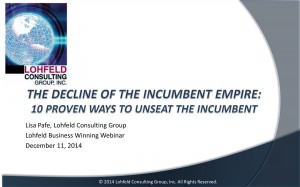Q&A Part 2 from The end of the incumbent empire – 10 ways to unseat the incumbent
In the past several years, incumbents have lost their advantage in the Federal Government market. Industry studies show that incumbent contractors now have approximately the same win rate on rebids as non-incumbents. Rapid technological change, as well as fiscal constraints, mean that customers are more willing to consider alternatives. Still, winning a bid against an incumbent contractor is a challenge because best informed wins, and the incumbent is still the best informed.
In this webinar, Lisa Pafe, CPP APMP and Lohfeld Consulting Group Principal Consultant, provides 10 proven best practices to create a competitive edge over the incumbent in today’s changing environment.
Click to watch the webinar replay and download the presentation and research brief.
(Look for Part 2 of The End of the Incumbent Empire: Remaining as Incumbent in the next couple of months.)
Here is Part 2 of the questions we received during the webinar with answers from Lisa Pafe.
Q: Do you have any advice for a small business that has recently graduated from the 8(a) program and must now learn to thrive and survive as “just another small business”? It is often said that to win in the government contracting game, a company must partner-partner-partner. With shrinking defense budgets, and all-too-common partnering, what should small businesses do to differentiate themselves into a competitive advantage?
A: My best advice is to get on as many multiple award vehicles as possible so that you can compete with a smaller pool of pre-qualified vendors. Partnering is definitely important in order to fill capabilities gaps. For each opportunity, you need to assess honestly whether you can differentiate yourself with a value proposition that addresses customer hot buttons. If you cannot, perhaps take a step back and consider a market strategy assessment.
Q: Do you think it is better to write an executive summary before the proposal is written or after the proposal is written? How can we better write to the client especially in the executive summary? It is about them not us.
A: Many companies place too much emphasis on the executive summary, which is typically not evaluated. Instead, before writing, concentrate on identifying features, benefits, and proofs corresponding to customer hot buttons. Next, determine which the evaluator would score as strengths to ensure you have as many strengths as possible and no weaknesses prior to writing. Once you have identified this information, you can write a better executive summary and a better proposal.
Q: Generally speaking, what is the pricing someone desiring to beat an incumbent has to get to (percentage wise) to be in the ballpark for unseating an incumbent? What does history tell us?
A: The market is seeing incumbent price erosion of 15–30%. Therefore, your price to win should likely be at least 15% below what was bid on the original contract, adjusting for any revised levels of effort or scope.
Q: Anything you can offer on the proper way to approach incumbent staff—as a group, individually—would be very helpful.
A: As the challenger, you must be very careful not to disrupt the workday of the incumbent staff. The best approach is to reach out to incumbents through LinkedIn. You can also hold group open houses after work near the office locations (advertise on your website and through LinkedIn messages).
Q: How best to determine the incumbent weaknesses in the eyes of the client?
A: Ask the customer (business, technical, contracts, budget stakeholders) what problems they are seeking to solve with the upcoming recompete procurement. What contract or mission objectives do they have? After RFP release, look for clues such as requesting new levels of effort, increased certifications and training, different scope, and the like. Try to reach out to teaming partners as well as current and former employees for additional insights.
Q: How does a small business with limited past performance citations respond to RFPs that require three or more citations.
A: The best approach is to team with a company that can provide additional past performance citations. If you cannot fill this capability gap, then make a no-bid decision.
Q: How do you offset incumbent strengths with customers (the love fest)? How do you encourage competition with the government customer? What ideas and methods help craft your solution?
A: The best way to offset incumbent strengths is to propose better and/or more strengths that benefit the customer by exceeding requirements, helping meet contract or mission requirements, and/or offering value-add. You encourage competition by positioning your strengths with the customer during the capture phase. The best method to use in crafting your solution is focusing on building the greatest number of strengths and mitigating all weaknesses prior to RFP release.
Paperback or Kindle
10 steps to creating high-scoring proposals
by Bob Lohfeld
contributors Edited by Beth Wingate
Subscribe to our free ebrief
Teaming friends, frenemies, and enemies—12 tips to mitigate harmful effects
Did you know that contracting officers spend up to 20% of their time mitigating disputes between teaming partners? In an informal poll we conducted on LinkedIn last month, 40% of respondents classified their teaming partners as “frenemies” on their last bid.
Explore Further
- Advice (446)
- AI (5)
- APMP (17)
- Business Development (198)
- Capture Management (197)
- Favorite Books (5)
- Go-to-Market (27)
- Graphics (6)
- Lohfeld Books (3)
- Past Performance (58)
- Post-submission Phase (15)
- Pre-RFP Preparation (211)
- Proposal Management (270)
- Proposal Production (60)
- Proposal Reviews (27)
- Proposal Writing (77)
- Pursuit Phase (89)
- Research Report (2)
- Resources (60)
- Tools & Tips (259)
- Training (10)
- Uncategorized (220)

Sign Up for INSIGHTS and Download your FREE book
We'd love to help you with your proposals. Enjoy our complimentary Lohfeld Consulting Group Capture & Proposal Insights & Tips book with your FREE subscription to our Insights Newsletter.
GET YOUR FREE BOOK





